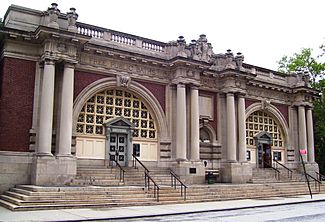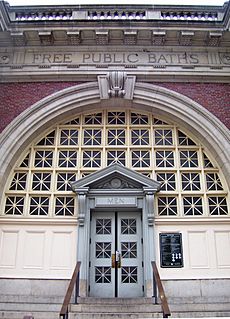Asser Levy Recreation Center facts for kids
|
Asser Levy Public Baths
|
|

(2010)
|
|
| Location | Asser Levy Place and East 23rd Street Manhattan, New York City |
|---|---|
| Built | 1905–1908 |
| Architect | Brunner & Aiken |
| Architectural style | Roman Revival |
| NRHP reference No. | 80002709 |
Quick facts for kids Significant dates |
|
| Added to NRHP | April 23, 1980 |
The Asser Levy Recreation Center is a fun place in the Kips Bay area of New York City. It includes the Asser Levy Public Baths building and the Asser Levy Playground. This recreation center is located between East 23rd Street and East 25th Street, near the FDR Drive.
The center is named after Asser Levy, an important person in early New York City history. He was one of the first Jewish citizens and worked hard to protect civil liberties (people's basic rights).
The main building, the Asser Levy Public Baths, was designed by architects Arnold W. Brunner and Martin Aiken. It has a grand entrance with two large arches and columns. Inside, you'll find rooms for activities, a swimming pool, and lockers. The bathhouse was built between 1905 and 1908 to help people in the city stay clean, as many homes didn't have bathtubs back then.
In 1938, the facility became part of the New York City Department of Parks and Recreation (NYC Parks). It was first called the East 23rd Street Baths but was renamed for Asser Levy later on. The bathhouse building is very special: it was made a New York City landmark in 1974 and added to the National Register of Historic Places in 1980. NYC Parks fixed up the building from 1988 to 1990. Other parts of the recreation center, like outdoor pools and the playground, were built in 1993 and 2014.
Contents
What's Inside and Outside?
The Asser Levy Recreation Center is in the Kips Bay neighborhood of Manhattan, on the East Side of New York City. The entire area is about 2.44 acres (almost 10,000 square meters). It's bordered by 23rd Street to the south, 25th Street to the north, and the FDR Drive and East River to the east.
The Asser Levy Public Baths building is shaped a bit like a cross. It was built between 1904 and 1906. The architects, Brunner & Aiken, designed it in a Roman Revival style. This means it looks like old Roman baths and was part of the "City Beautiful" movement, which aimed to make cities more beautiful and grand.
The Bathhouse Look
The outside of the bathhouse is mostly made of red Harvard brick. The bottom part is made of light-colored limestone. The main entrance faces west. It has two big arches, each with pairs of round columns.
When it first opened, these arches were separate entrances for men and women. Men used the northern arch, and women used the southern arch. Inside each arch are smaller doors. A fancy stone at the top of each arch is called a keystone. One historian said the arches looked "more like portals to a great amphitheatre" than just doors.
Between the two arches, there's a decorative spot with a fountain. Above it is the shield of New York City. At the very top of the entrance, you can see words carved into the stone: "free public baths" above the northern arch and "city of new york" above the southern arch. There are also decorative urns (vases) on top.
The sides of the building have round windows. The roof is made of copper and has an iron skylight that lets light into the pool area.
Inside the Building
The Public Baths building holds the indoor parts of the recreation center. Because of the soft ground underneath, the building was built on strong supports called pilings and doesn't have a basement.
Originally, the men's areas were on the north side, and the women's areas were on the south side. There were separate waiting rooms for each gender. These rooms have now been combined into one large lobby with a tall, arched ceiling. This space is now used for games like table tennis and pool.
Just past the lobby, in the middle of the bathhouse, is a very tall room with the indoor swimming pool. This room is called a natatorium. The pool is about 66 feet (20 meters) long and 26 feet (8 meters) wide. It's about 4 feet (1.2 meters) deep at one end and 7 feet (2.1 meters) deep at the other. The pool has a cool bronze lion's head fountain at the shallow end. The walls around the pool are covered in ceramic tiles. There's also a balcony overlooking the pool on the second floor. A large skylight above the pool lets in natural light.
Next to the waiting room, on either side of the pool, were the shower rooms. When the bathhouse opened, it had more than 150 shower stalls! Everyone had to shower before getting into the pool. After a renovation in 1990, these areas were changed to include a multipurpose room, a media lab, and a fitness room.
Outdoor Fun
Outside the bathhouse building, there's a large outdoor swimming area. This includes a main swimming pool and a smaller wading pool for younger kids. The main outdoor pool is about 120 feet (36.5 meters) long, 45 feet (13.7 meters) wide, and 4 feet (1.2 meters) deep. The wading pool is about 41.67 feet (12.7 meters) long and 25 feet (7.6 meters) wide, and only 1.5 feet (0.46 meters) deep.
The recreation center also has lots of other outdoor activities. You can find outdoor exercise equipment, handball courts, basketball courts, an artificial turf field, a running track, and sprinklers for cooling off. The basketball court and playground are near the FDR Drive. There are four handball courts at 25th Street. The fitness equipment, soccer field, and running track are in the western part of the center, where Asser Levy Place used to be.
History of the Center
Building the Baths
The Asser Levy Public Baths were built to help solve a big problem in New York City: sanitation. In the early 1900s, many people, especially immigrants living in crowded apartments, didn't have bathtubs at home. A survey in 1896 found that in one area, there was only one bathtub for every 79 families!
Social reformers, who wanted to improve society, pushed for public bathhouses like those in ancient Rome. In 1895, a state law was passed that required cities to build public baths. Before this, some floating baths existed on the rivers, but they weren't very clean. New York City's first public bathhouse opened in 1901. By 1912, there were 23 bathhouses across the city, including what is now the Asser Levy Public Baths.
In 1903, land was set aside for the new bathhouse. Architects Aiken and Brunner were hired. The plans were finished in 1904, and construction began in June 1905. The bathhouse opened on January 20, 1908, with a special ceremony. Famous swimmers even competed in the indoor pool that day! At first, men and women used the pool on different days of the week.
Changes and Upgrades
The outdoor pool and a diving pool were added in 1936. In 1938, the 23rd Street Bathhouse was given to the New York City Department of Parks and Recreation (NYC Parks) to manage.
In the 1940s and 1950s, a new housing complex called Stuyvesant Town–Peter Cooper Village was built nearby. This caused the street outside the bathhouse, Avenue A, to be cut off. In 1954, this part of the street was renamed Asser Levy Place, honoring the important citizen. The bathhouse also became known by his name.
The Asser Levy Public Baths building was officially recognized as a New York City landmark on March 19, 1974. It was also added to the National Register of Historic Places on April 23, 1980.
By the late 1970s, the indoor pool wasn't used or heated in winter. In 1979, the pool's boiler broke, and the indoor pool closed for a while. In the late 1980s, the city decided to spend $8 million to fix it up. The bathhouse reopened on June 28, 1990, looking much better.
In October 1993, a new playground opened next to the building. This playground was special because it was the first in Manhattan that was fully accessible for children with disabilities.
In 2011, the New York City government decided to turn Asser Levy Place into an extension of the recreation center. This was part of a deal where the city sold some land to the United Nations. Asser Levy Place was permanently closed in 2013, and work on the park extension started that November. The expanded Asser Levy Playground officially opened in February 2015, giving even more space for fun and activities.
See also
 In Spanish: Asser Levy Public Baths para niños
In Spanish: Asser Levy Public Baths para niños



